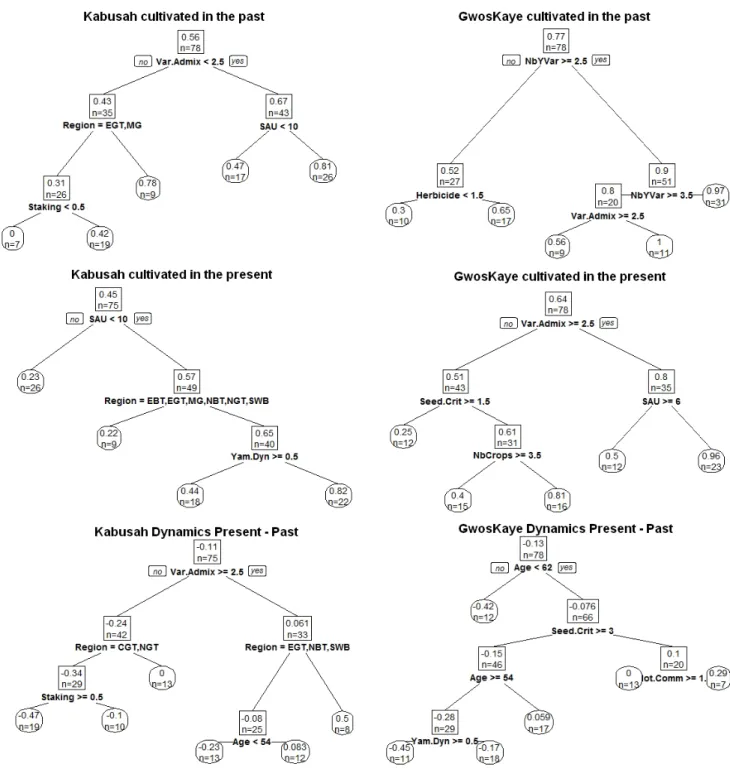HAL Id: hal-02743955
https://hal.inrae.fr/hal-02743955
Submitted on 3 Jun 2020
HAL is a multi-disciplinary open access
archive for the deposit and dissemination of
sci-entific research documents, whether they are
pub-lished or not. The documents may come from
teaching and research institutions in France or
abroad, or from public or private research centers.
L’archive ouverte pluridisciplinaire HAL, est
destinée au dépôt et à la diffusion de documents
scientifiques de niveau recherche, publiés ou non,
émanant des établissements d’enseignement et de
recherche français ou étrangers, des laboratoires
publics ou privés.
Varietal dynamics in yam producers from Guadeloupe:
cultivation trajectories for two commonly grown cutivars
Claude Pavis, Laurent Penet, Jean-Marc Blazy, François Bussière, Sébastien
Guyader, Angela Alleyne, Denis Cornet
To cite this version:
Claude Pavis, Laurent Penet, Jean-Marc Blazy, François Bussière, Sébastien Guyader, et al..
Vari-etal dynamics in yam producers from Guadeloupe: cultivation trajectories for two commonly grown
cutivars. 52. Annual meeting CFCS, Jul 2016, Le Gosier, Guadeloupe, France. �hal-02743955�
Paper presented at the 52nd CFCS Annual Meeting Meeting, Guadeloupe, July 10-16, 2016.
VARIETAL DYNAMICS IN YAM PRODUCERS FROM GUADELOUPE: CULTIVATION
TRAJECTORIES FOR TWO COMMONLY GROWN CUTIVARS
L. Penet
1, Cornet
2D, Blazy
1J.M., Alleyne
3A., Barthes E., Bussière
1F., Guyader
1S, Pavis
1C. and D.
Petro
11 INRA, UR1321, ASTRO, Agrosystèmes tropicaux, 97170, Petit-Bourg (Guadeloupe), France. 2 CIRAD, UMR
AGAP, Petit-Bourg, F-97170, Guadeloupe, France 3 Department of Biological and Chemical Sciences, University of
the West Indies, Cave Hill Campus, BB 11000, Barbados
Keywords Agro-diversity, Dioscorea, Varietal turn over, Yam Abstract
Loss of agrodiversity mediated by varietal legacy is an important concern, translating as crop species being at risk for genetic erosion, while loss of genetic resources may deplete material available for future breeding strategies. We explored varietal dynamics in the Guadeloupean agricultural yam system. Interviewing farmers about the varieties cultivated in the past compared to their current varieties demonstrated that no dramatic loss of varieties occurred in the two to three latest decades, and changes in variety frequency mostly affected former widespread varieties while frequency of uncommon varieties demonstrated some stability in cultivation frequency. Varietal dynamics nevertheless reflected strong sub-regional trends, and socio-economic impacts such as age of producers or farm levels of crop diversity.
Materials and methods :
We interviewed seventy eight yam producers about their yam varieties and species, delineating from varieties they had grown in the past, from their current varieties. Along with information about grown varieties, we collected information about their cropping strategies and cultivation methods. Early results (Penet et al, submitted) demonstrated that while a pattern toward loss of agro-diversity was observed, it mostly affected the most frequent varieties. Here, we explore this pattern with two cultivars most frequently cultivated by yam producers in Guadeloupe: Kabusah (Dioscorea alata) and GwosKaye (Dioscorea rotundata-cayenensis), using regression tree analyses. Main results : Stratification (Figure 1) Kabusah GwosKaye Past cultivation
Producers enclined to admix varieties in the fields, and cultivation rate was even higher in small size farms; Else there’s a subregional component for cultivation of the variety (East Grande Terre and Marie Galante mainly), and other producers were mostly staking the variety.
Cultivar chosen more often by producer with higher agro-diversity and growing yams with small scale plot admixture; Otherwise cultivation of GwosKaye was more frequent in producer with lower use of chemicals.
Present cultivation
Cultivation decreased more strongly in bigger farms and the variety is still mostly grown in medium to small size farms, but its prevalence increased in other sub-regions and is most important in producers expressing commitment to the crop.
Today, this variety is more cultivated by producers practicing higher admixture and in medium size farms;
Else it is found more often in producers with quality criteria for tuber seeds, especially if they are diversified (high number of crops at farm level).
Cultivar Dynamics (comparison Past vs. Present cultivation) There’s a decrease of 11% in
cultivation of this variety compared to past cultivation. Pattern of loss is strongly sub-regional, though mitigated by age or practice of staking.
Decrease of 13% cultivation, with younger producers with higher quality criteria (both for seed and plot workload) demonstrating higher cultivation rates, while older or less satisfied farmers losing the cultivar.
Paper presented at the 52nd CFCS Annual Meeting Meeting, Guadeloupe, July 10-16, 2016.
Figure 1. Regression Tree analyses of varietal trajectories: cultivation in the past, current cultivation and varietal
dynamics over the latest three decades (Present – Past). On the left, trajectory for variety Kabusah, on the right, trajectory for GwosKaye. Variance explained by the different models: Kabuash Past = 25%, Kabusah Present = 25%, Dynamics Past-Present = 37%, GwosKaye Past = 34%, GwosKaye Present = 32%, Dynamics Past-Present = 26%.
Conclusion :
These common cultivars (from different species) demonstrated different cultivation trajectories, with Kabusah having a strong sub-regional component and recurrent interaction with practice of staking and GwosKaye presenting important structuration with quality factors (seed quality, commitment to plot workload). Both showed decline but kept intrinsic factors structuring reasons for cultivation.
Bibliografic references: Authors’ notification:
Paper presented at the 52nd CFCS Annual Meeting Meeting, Guadeloupe, July 10-16, 2016.
These results are under review. If you are interested, you may contact the first author at laurent.penet@antilles.inra.fr, who will gladly send a reprint after acceptance or discuss the specifics directly with you.
